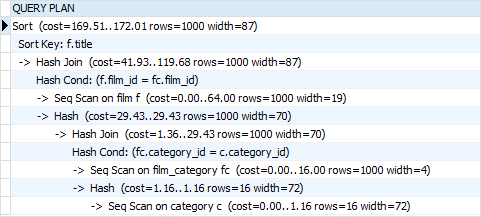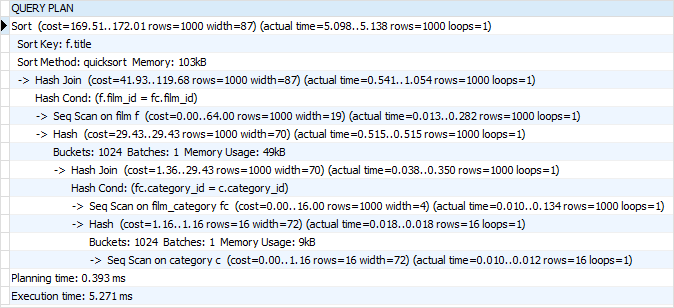Different Formats of Explain Plan in Postgres
Execution plans can become a very beneficial weapon for all database developer. The most important and useful information that the.
Typically the best way to call EXPLAIN is.

. EXPLAIN ANALYZE VERBOSE SQL statement EXPLAIN option Option to be define in plan of SQL statement SQL statement Where option in explains analyze can be one of the following. Sequence Scan meaning that it will. Okay lets break that down.
EXPLAIN ANALYZE BUFFERS SQL statement. SQL EXPLAIN PLAN FOR select prod_category avg amount_sold from sales s products p. It includes the start up time of any of its child nodes but not of any non-child nodes even if it cant do any work until the non-child nodes does something.
They give a broader knowledge of the mechanisms involved in the processing of queries. In the next section we will use these tools to examine how the PostgreSQL query plan works. Lines 24 are just any DML.
As of February 2020 PostgreSQL is placed on the 4th place by popularity falling behind only Microsoft SQL Server MySQL and Oracle. I- Start-up cost - start up a node to start the process of the query. Explain and Explain Analyze.
In this case JSON. The syntax for creating the plan in PostgreSQL is. Analyzing the execution plan can show you how to improve performance by optimizing the database.
You can use this command directly in your SQL query as long as the query starts with it. Here we are told that this query will do a Seq Scan aka. The default output 1 indents additional steps that need to perform the step above it.
Postgres always choose the execution plan with the lowest possible value. Postgres builds a tree structure of plan nodes representing the different actions taken with the root and each - pointing to one of them. As we mentioned earlier the EXPLAIN statement allows you to view the execution plan for a query.
Ii- Total cost -. If you want to feed EXPLAIN s output to a program for further analysis you should use one of its machine-readable output formats XML JSON or YAML instead. PostgreSQL has many tools which the developer can make use of and one such tool is the EXPLAIN command.
Be patient if youre new to analyzing query plans it can take time to master the art of interpreting them. One method for optimizing queries is to examine the query plan to see how a query is executing and adjust the query to be more efficient. In this series of Blogs Im going to explain about the execution plan in PostgreSQLHow it works and how performed scans and Joins on the statement by Optimizer.
In some cases EXPLAIN ANALYZE provides additional execution statistics beyond the execution times and row counts such as Sort and Hash above. In some cases EXPLAIN ANALYZE provides additional execution statistics beyond the execution times and row counts such as Sort and Hash above. ANALYZE boolean VERBOSE boolean COSTS boolean BUFFERS boolean.
Include SETTINGS if you are on v12 or better and WAL for data modifying statements from v13 on. When running this on GitLab. The examples use EXPLAINs default text output format which is compact and convenient for humans to read.
EXPLAINANALYSEBUFFERSVERBOSEFORMAT JSON is how you would export in a specific format. The first thing to notice about the EXPLAIN output is that its named Query Plan and the second is that it has two lines the second being indented. Elements of a Query Plan.
Using the query plan can provide many insights into why a query is running inefficiently. The EXPLAIN keyword in PostgreSQL helps you to generate the execution plan of a query in PostgreSQL. Hold on let me EXPLAIN.
The EXPLAIN shows how tables involved in a statement will be scanned by index scan or sequential scan etc and if multiple tables are used what kind of join algorithm will be used. In postgreSQL the query plan can be examined using the EXPLAIN command. This command can be invaluable when trying to determine how a query will perform.
Postgres builds a tree structure of plan nodes representing the different actions taken with the root and each - pointing to one of them. Any line other than the first without an - is such information so the structure. For ease of reading we will only be looking at the Text format of a PostgreSQL query plan.
The following examples illustrate how to generate and display an execution plan for our original SQL statement using the different functions provided in the dbms_xplan package. Uses the EXPLAIN PLAN command and the DBMS_XPLANDISPLAY function. It is highly commendable to set track_io_timing on to get data about the IO performance.
EXPLAIN OPTION YOUR_SQL_QUERY. The startup cost is the estimated cost until it delivers its first row not until it receives its first row. As I understand the nodes that have the startup cost equals to 0 will be the nodes that gets run first This is not correct.
Below is the syntax of explaining analyze in PostgreSQL are as follows. The EXPLAIN command returns the execution plan which the PostgreSQL planner creates for a given statement. Show activity on this post.
As you correctly mention the difference between explain explain analyze is that the former generates the query plan by estimating the cost while the latter actually executes the query. Thus explain analyze will give you more accurate query plan cost. PostgreSQL allows you to obtain query plans using the EXPLAIN command.
However you dont want to explain analyze any. EXPLAIN FORMAT JSON ANALYZE BUFFERS SELECT first_name last_name FROM people WHERE first_name Alice. The EXPLAIN statement returns the execution plan which PostgreSQL planner generates for a given statement.
EXPLAIN SELECT COUNT FROM projects WHERE visibility_level IN 0 20. PostgreSQL EXPLAIN statement.

Comments
Post a Comment